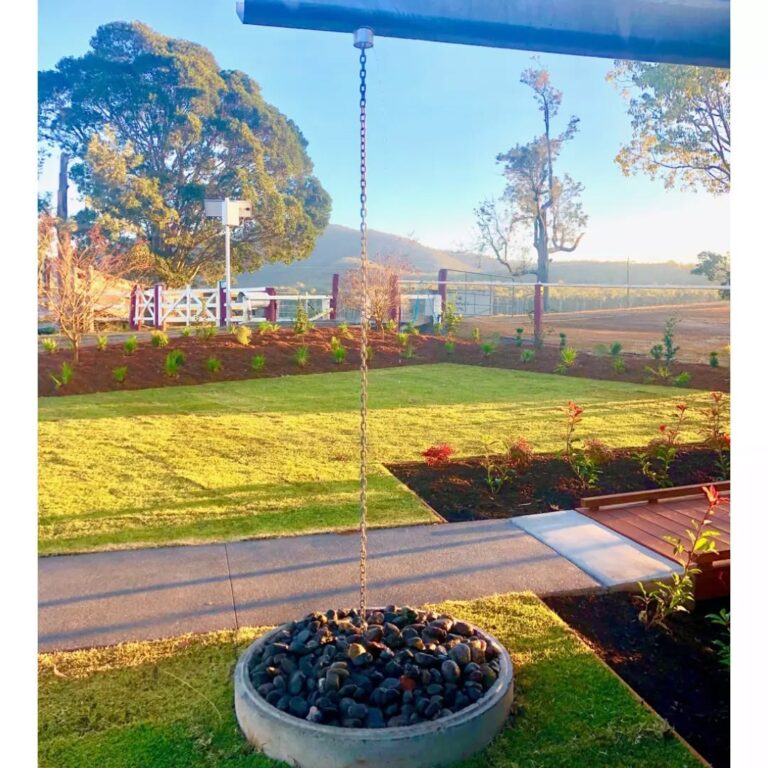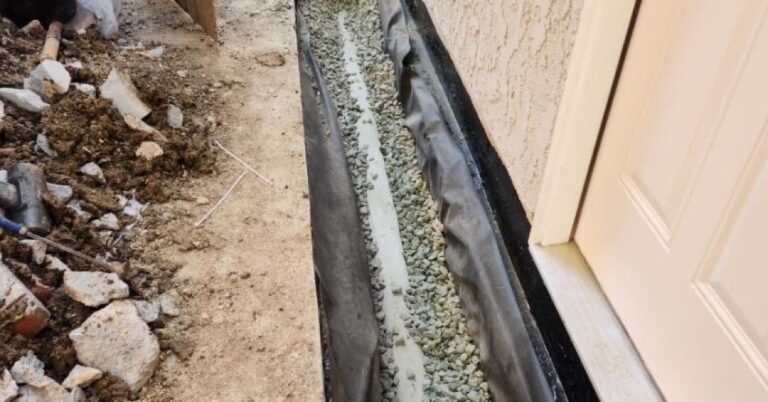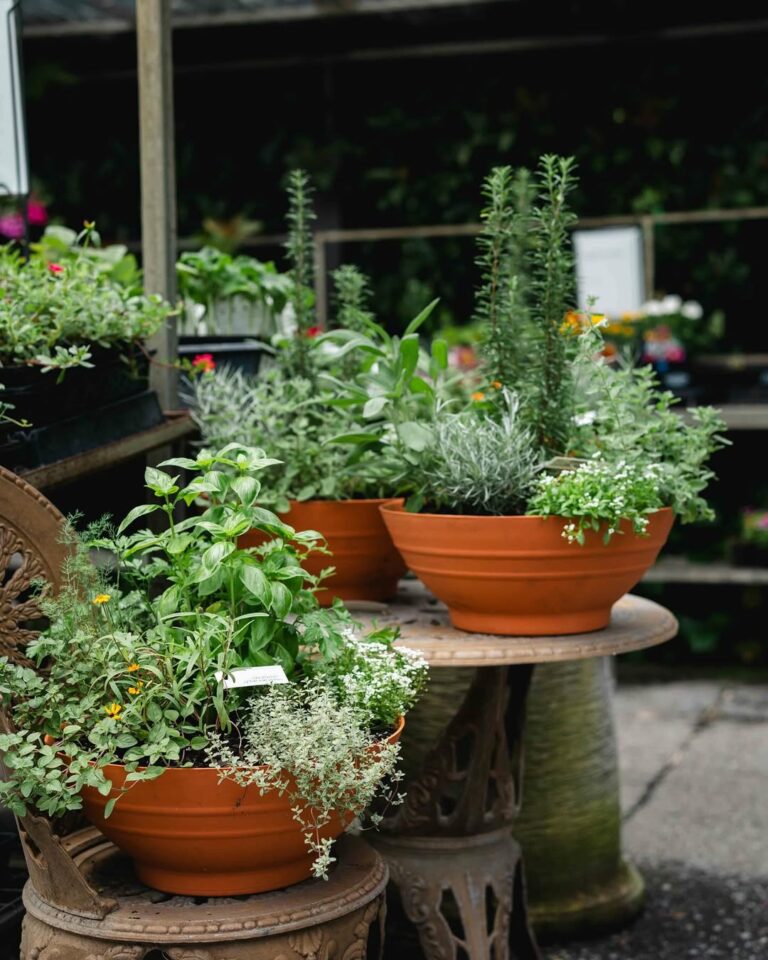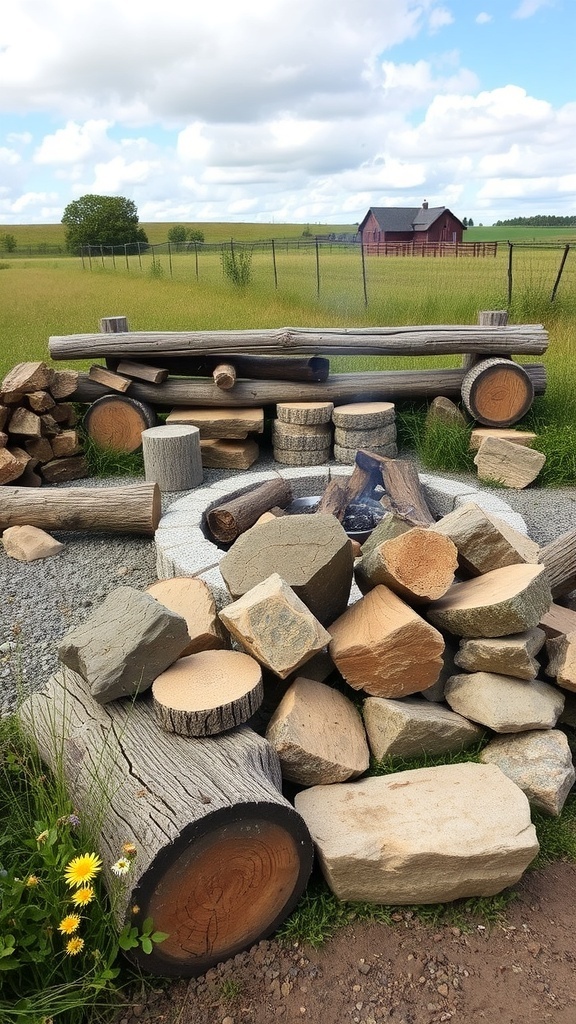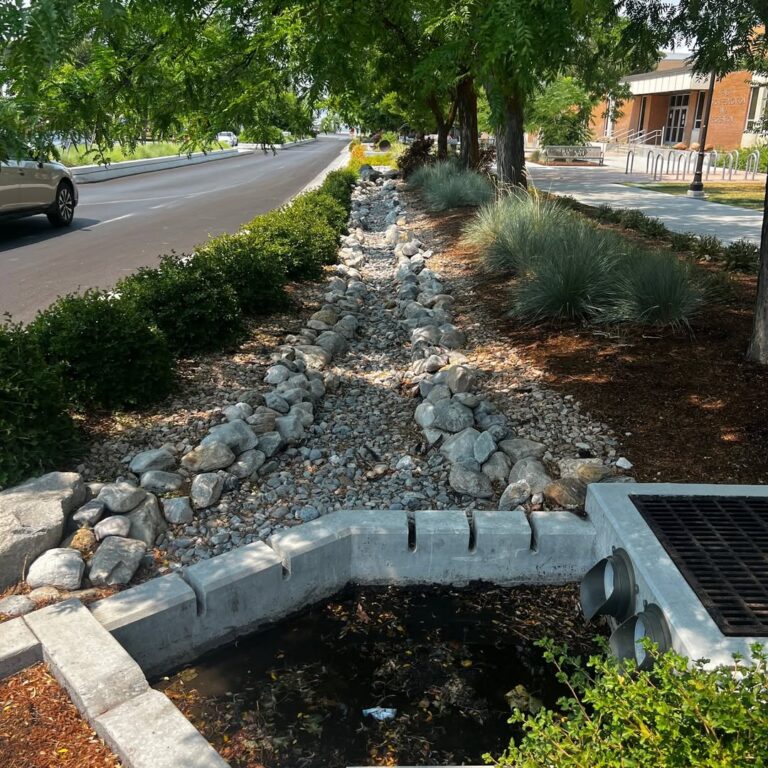15 Dry Rock Bed Ideas for Drainage: A Comprehensive Guide
Creating a functional and aesthetically pleasing drainage solution for your garden or yard can be both practical and beautiful. One of the most effective methods for improving drainage is through the use of a dry rock bed. Not only does it help with water management, but it also adds a unique, natural touch to your outdoor space. In this article, we’ll explore 15 dry rock bed ideas for drainage that can help you achieve a well-maintained, attractive landscape.
1. River Rock Dry Bed
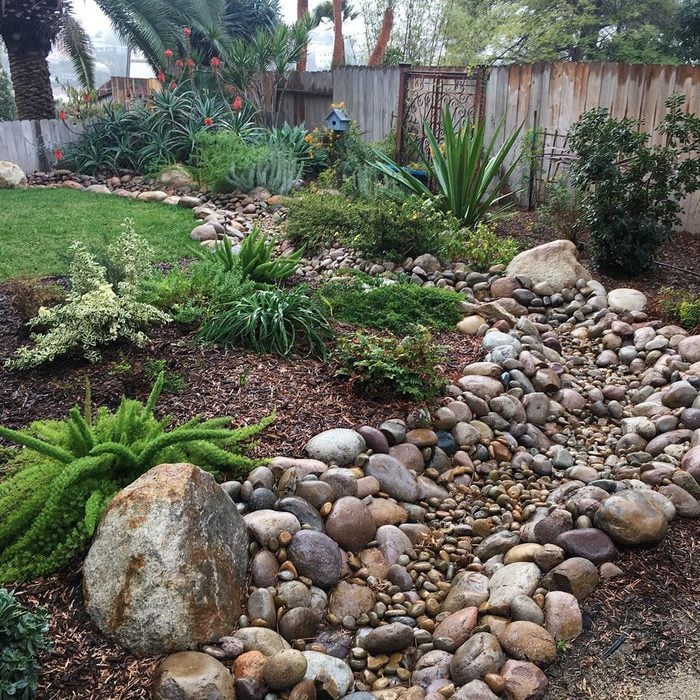
A river rock dry bed is a classic and stylish solution for drainage issues. The rounded stones, often ranging in color from earthy browns to soft grays, create a natural riverbed effect. This type of dry rock bed works exceptionally well in areas with moderate rainfall. The smooth surface of the river rocks allows water to flow through quickly, preventing pooling in your yard or garden.
For a more rustic look, you can blend various sizes of river rocks, creating a textured effect that resembles a natural creek bed. It’s ideal for sloping areas or spaces that tend to collect excess water after storms. River rock beds can also be lined with landscape fabric to reduce weed growth while still allowing water to filter through.
The versatile nature of river rocks allows them to be used in various garden styles, from modern landscaping to traditional cottage gardens. It’s a low-maintenance yet highly effective drainage solution that adds beauty to your outdoor space.
2. Pea Gravel Drainage Bed
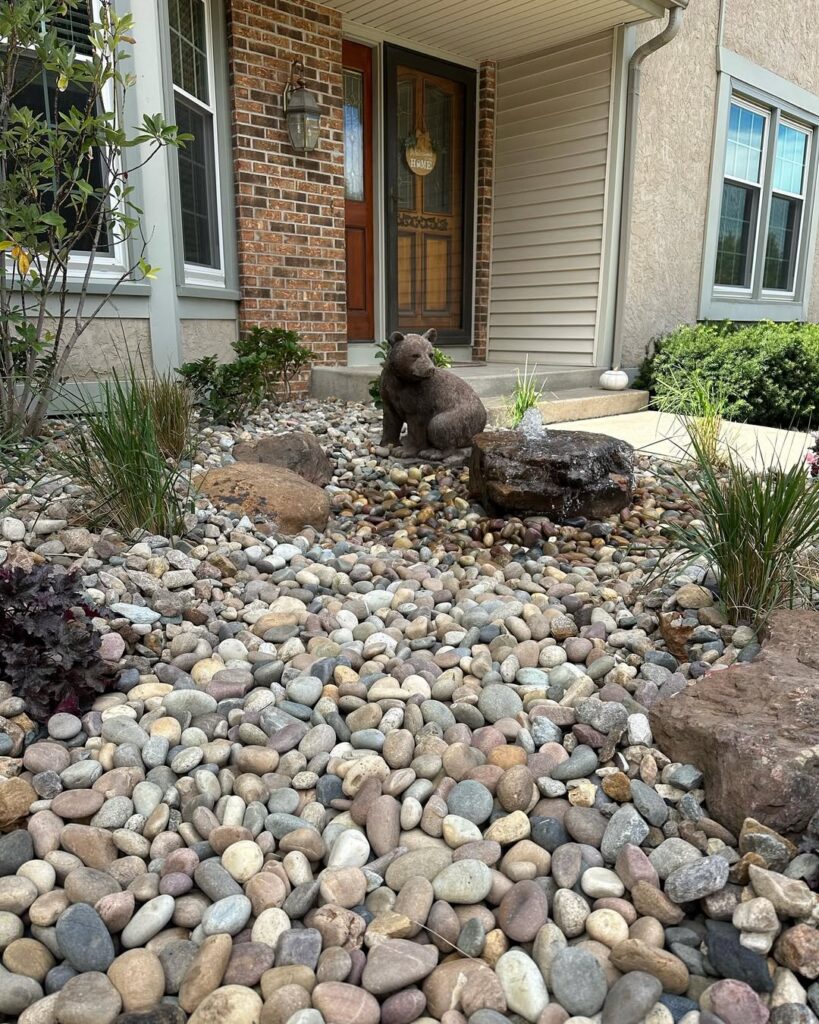
Pea gravel is an excellent choice for creating a dry rock bed designed to manage drainage. The small, smooth pebbles are easy to walk on and can be placed in different patterns, offering both function and aesthetic appeal. Pea gravel is ideal for areas that experience heavy rainfall, as its loose structure allows water to quickly drain through without creating a muddy mess.
A pea gravel drainage bed works well in both front and backyards, particularly in walkways or between garden beds. The stones can also be combined with larger rocks for visual contrast, or even used as a border around a garden feature. Additionally, pea gravel is great for creating dry creek beds that mimic natural water flow.
Since pea gravel doesn’t compact, it allows water to flow freely, preventing erosion and pooling. For best results, install a layer of landscaping fabric underneath the gravel to ensure proper drainage and prevent the growth of unwanted weeds.
3. Cobblestone Rock Bed
Cobblestones bring a touch of elegance and durability to your drainage system. These larger, flat stones are typically used in more formal settings, such as European-style gardens or Mediterranean landscapes. Cobblestone dry beds are perfect for areas where you want to manage water while maintaining an organized, refined look.
Cobblestone rock beds work well in paths, driveways, or around patios. The stones can be arranged in various patterns, from straight lines to intricate geometric shapes, adding a level of sophistication to the area. The gaps between the cobblestones allow water to filter through easily, and the stones are sturdy enough to handle foot traffic and landscaping equipment.
To enhance the aesthetic appeal, you can also incorporate small plants like moss or creeping thyme between the cobblestones. This creates a natural yet controlled effect that complements the hardscape design.
4. Flagstone Dry Rock Bed
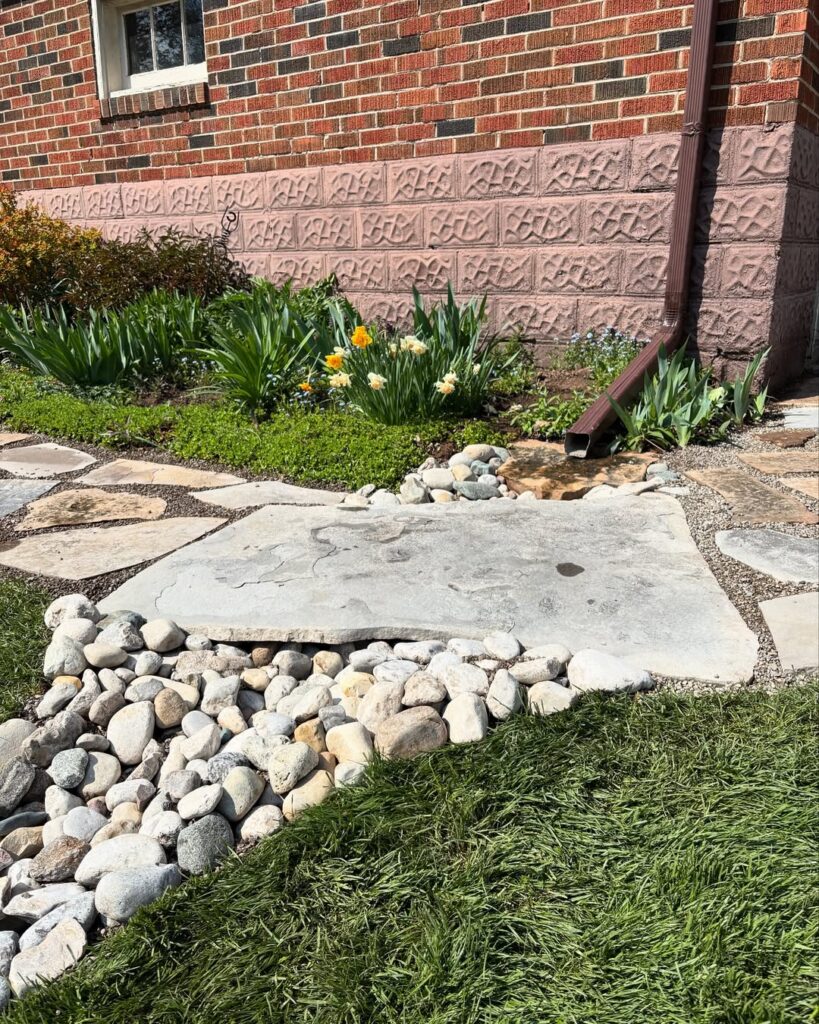
Flagstone is another popular option for creating a dry rock bed for drainage. This flat, rectangular stone has a more contemporary look compared to cobblestones and can be used to create both formal and informal drainage systems. Flagstone works well in spaces where you want a more uniform, structured appearance.
For drainage, flagstones can be laid with wide gaps between them, allowing rainwater to flow through into the soil below. This type of dry rock bed is ideal for areas with light to moderate rainfall, as it offers a balance between functionality and aesthetic appeal.
Flagstone can be used around garden borders, patios, or even to create a dry creek bed that leads water away from critical areas like your home’s foundation. The versatile nature of flagstone also makes it easy to pair with other materials, such as river rocks or pea gravel, for added texture and visual interest.
5. Crushed Limestone Drainage Bed
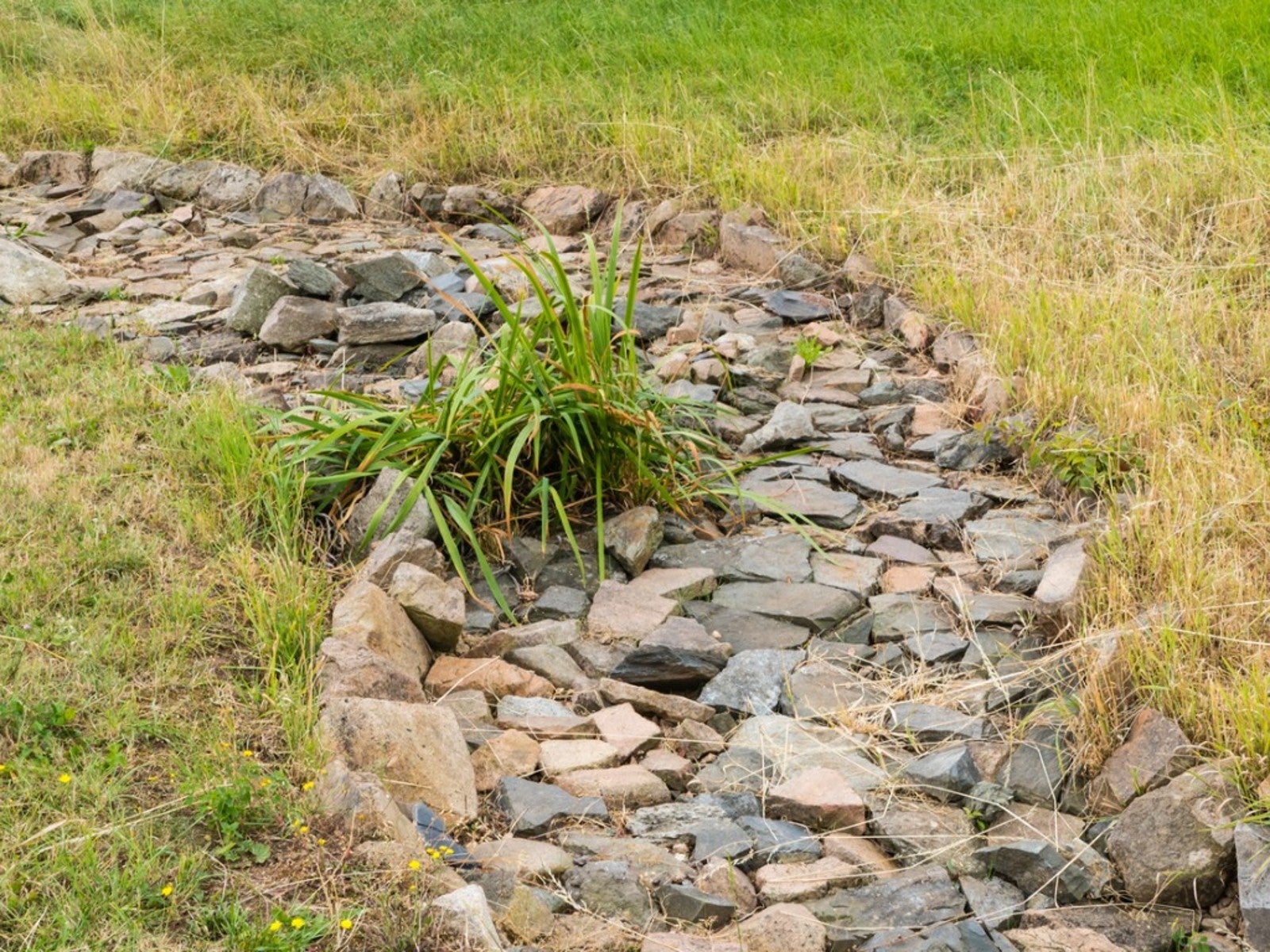
Crushed limestone is a great material for dry rock beds, particularly in areas where water needs to be diverted over a larger area. The jagged edges of crushed limestone allow the stones to interlock, creating a stable surface that helps prevent erosion while still allowing for water drainage. This type of rock bed is highly effective in areas that experience frequent heavy rainfall.
Crushed limestone is often used in larger-scale drainage solutions, such as around buildings, driveways, or as a part of a larger landscaping project. The material is highly durable, and its light color contrasts beautifully with darker plantings and garden features.
For added functionality, you can layer crushed limestone with other materials, such as a fabric liner, to prevent soil erosion while ensuring that water flows freely into the drainage system.
6. Decorative Gravel Drainage Bed
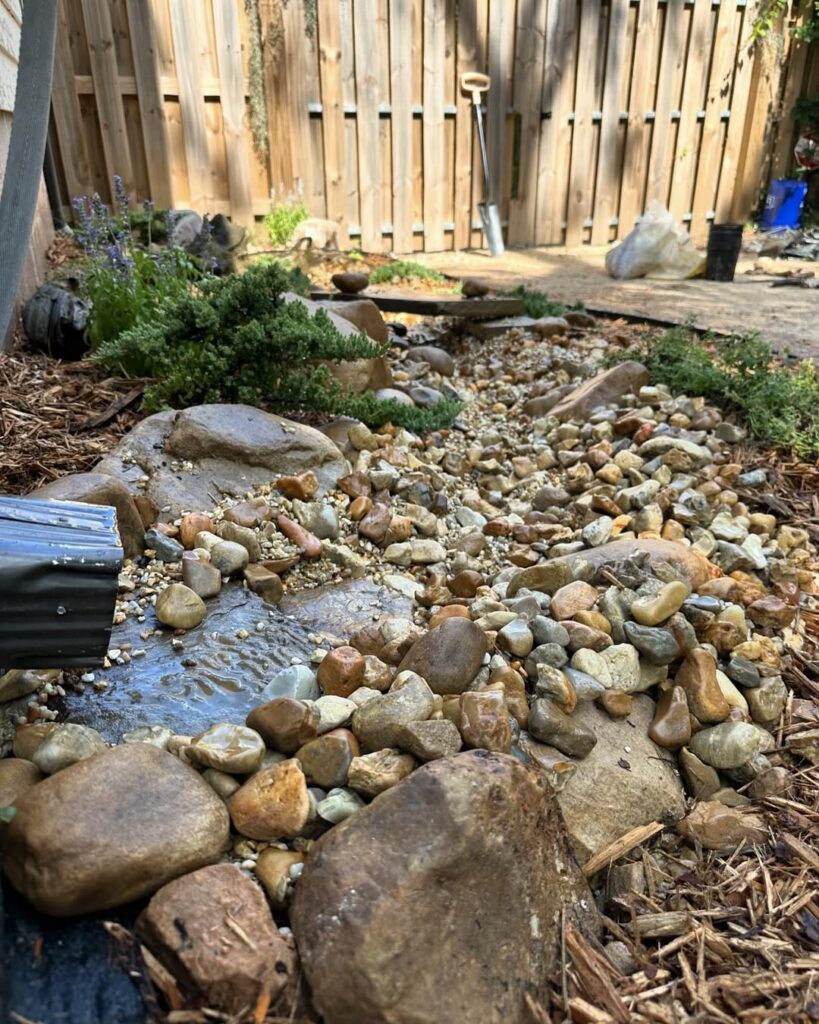
Decorative gravel is an excellent way to create a dry rock bed that serves both practical and aesthetic purposes. This type of gravel is available in various colors, sizes, and textures, allowing you to choose the perfect match for your landscape design. The gravel works well in both small and large areas, making it a versatile solution for managing water runoff.
A decorative gravel drainage bed can be used to create a beautiful focal point in your garden or yard. Whether you prefer a minimalist design or a more vibrant, multicolored scheme, decorative gravel enhances the overall look of the landscape while providing excellent drainage capabilities.
In addition to its visual appeal, decorative gravel is an effective material for areas with light to moderate rainfall, as the small stones allow water to filter through efficiently. To ensure proper drainage, be sure to use a landscape fabric beneath the gravel to prevent weed growth and soil erosion.
7. Lava Rock Dry Bed
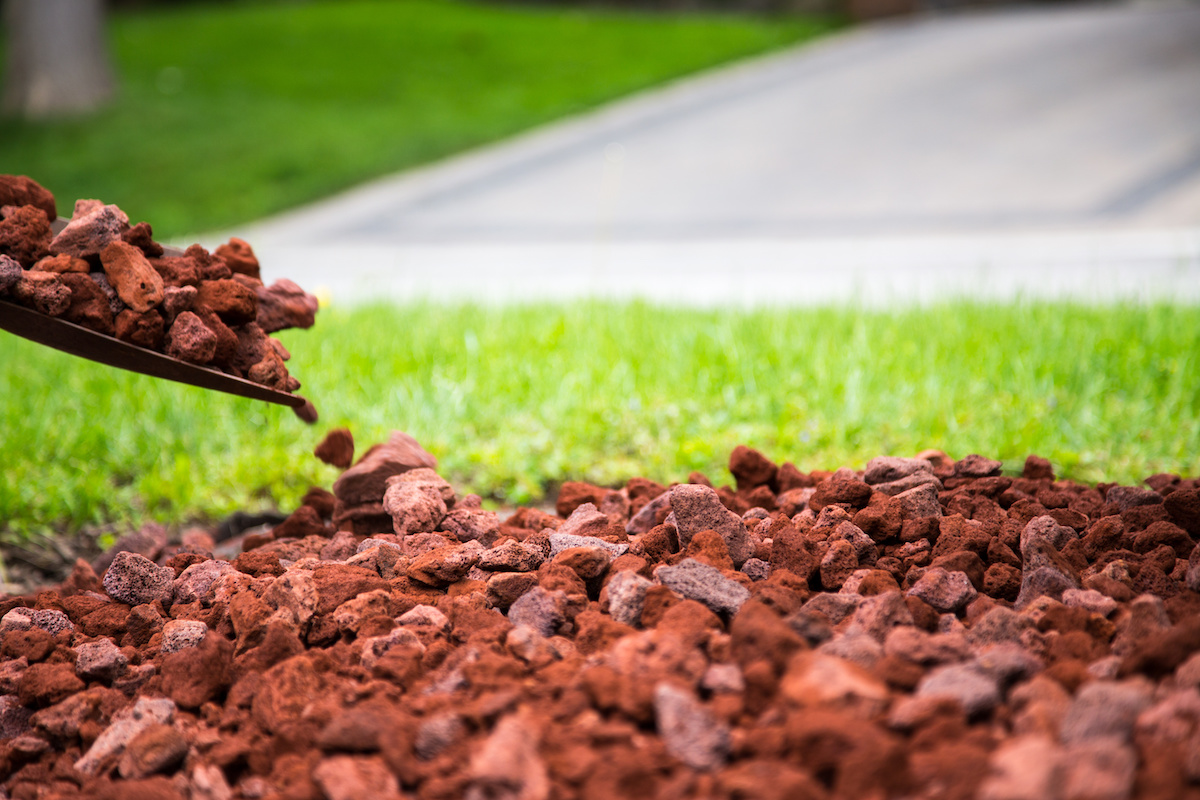
Lava rock is a unique and striking material that can be used to create a dry rock bed that is both functional and visually interesting. The porous texture of lava rocks allows water to filter through easily while offering excellent drainage properties. Their rich, dark color provides a striking contrast to lighter-colored stones or garden plants.
Lava rocks work particularly well in modern or southwestern-style gardens, where bold and dramatic elements are preferred. The stones can be placed in a variety of designs, from straight lines to more organic patterns, depending on the look you want to achieve. Lava rock is also highly durable and resistant to weathering, making it a long-lasting option for drainage solutions.
Because lava rock is so porous, it can hold moisture, which may be beneficial for some garden plants. However, it’s best used in areas where the goal is to direct water away from structures or garden beds, ensuring that water flows freely through the rock bed without pooling.
8. Granite Rock Dry Bed
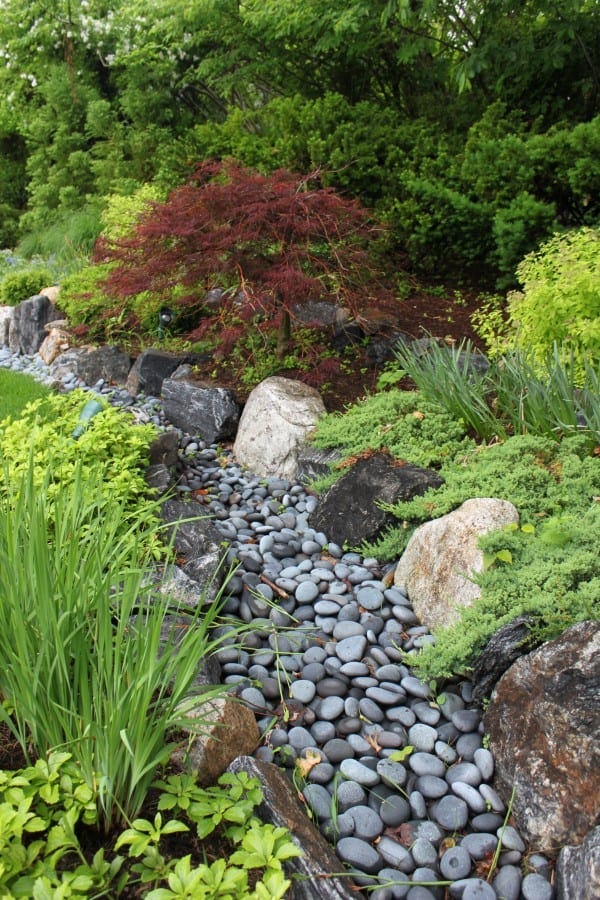
Granite is one of the most durable materials available for dry rock beds, offering both beauty and functionality. The rough, angular texture of granite stones allows them to interlock tightly, creating a stable surface that prevents erosion while allowing for efficient water drainage.
Granite dry beds are particularly suited for areas with heavy rainfall or where water needs to be directed away from buildings, walkways, or garden beds. The stones can be placed in various patterns, from simple lines to more intricate designs, depending on the desired effect. Granite’s natural gray color complements a wide range of landscape styles, from modern minimalist to more traditional designs.
Due to its durability and ability to withstand the elements, granite is a fantastic option for areas with heavy foot traffic or landscaping equipment. It’s also resistant to weed growth, making it a low-maintenance option for homeowners looking to reduce garden upkeep.
9. River Pebble Drainage Bed
:strip_icc():format(webp)/How-To-Create-a-Dry-Creek-101273403-c315d1c019b94898af5c35772bd1f140.jpg)
River pebbles are another excellent option for creating a dry rock bed for drainage. These smooth, rounded stones are often used in both landscaping and drainage solutions, offering an attractive way to manage water runoff. River pebbles work particularly well in smaller areas, such as around garden beds, pathways, or under trees, where you want water to flow freely and prevent pooling.
River pebbles are available in various colors, from soft whites to rich browns, allowing you to choose the perfect hue to match your landscape. The stones’ smooth surface allows for easy movement of water, ensuring that drainage issues are effectively addressed.
In addition to being functional, river pebbles are a great option for creating a natural, organic look. They can be combined with larger rocks or other materials to create visual interest and texture in your dry rock bed.
10. Sandstone Rock Dry Bed

Sandstone is a beautiful and durable material for creating a dry rock bed that manages water runoff effectively. The natural, warm tones of sandstone give it a soft, earthy appearance, making it ideal for more rustic or naturalistic landscapes. The stones are typically flat and can be arranged to create a smooth, even surface that allows water to flow through easily.
Sandstone is an excellent choice for areas with light to moderate rainfall, where you want to manage drainage while enhancing the overall beauty of your outdoor space. The warm colors of sandstone work well with other natural materials like wood, gravel, and plants, making it a versatile option for a wide range of garden styles.
Due to its natural porosity, sandstone absorbs moisture, which can be beneficial in some garden settings. However, it’s best used in areas where you want to guide water away from critical structures or plant beds.
11. Slate Rock Dry Bed
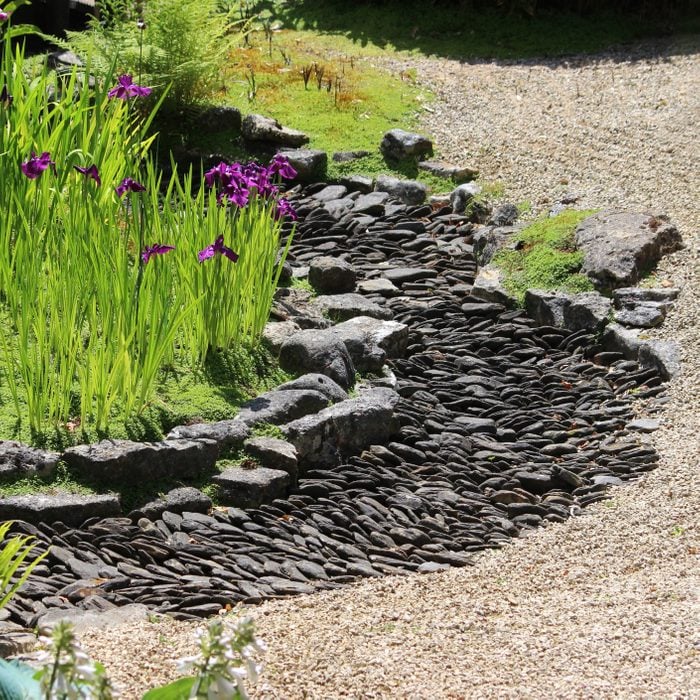
Slate rocks offer a refined, elegant solution for creating a dry rock bed for drainage. Known for their smooth, flat surface and deep, rich colors, slate stones can transform an ordinary drainage system into a beautiful garden feature. Their dark tones, ranging from blue to deep purple, provide a striking contrast when paired with lighter-colored landscaping elements or plants.
Slate is an ideal choice for areas where you want to create a more structured look, such as along pathways, around garden borders, or even as part of a dry creek bed. The stones can be arranged with minimal spacing, allowing water to filter through while still creating a visually cohesive design.
Additionally, slate is highly durable and weather-resistant, making it a long-lasting option for drainage systems. It’s also relatively low-maintenance, as the stones are unlikely to shift or become uneven over time, ensuring your rock bed remains stable and functional for years to come.
12. Quartzite Rock Drainage Bed

Quartzite is a stunning material for a dry rock bed, offering both durability and visual appeal. These hard, dense stones come in a variety of colors, from cool blues to warm oranges, giving you the flexibility to match your landscaping design. Quartzite’s natural sparkle and shine make it an eye-catching addition to any garden or yard.
This type of stone works exceptionally well in areas with heavy rainfall or soil erosion issues, as the hardness of quartzite ensures that the stones will not break down over time. When placed in a drainage bed, quartzite allows water to flow through efficiently, preventing pooling while creating a stable surface.
Quartzite’s resistance to weathering also makes it a fantastic option for areas with high foot traffic. Whether used in pathways, around garden beds, or as part of a larger drainage system, quartzite enhances both the functionality and aesthetic of your landscape.
13. Basalt Rock Dry Bed
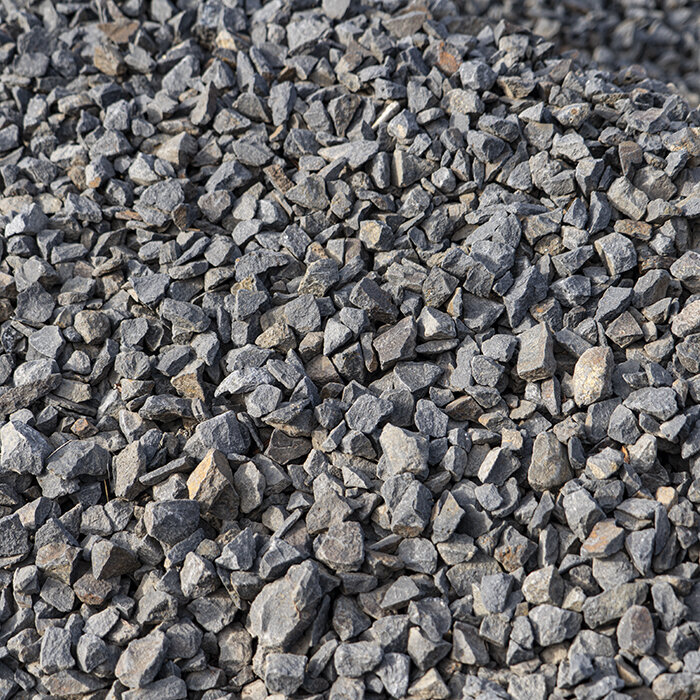
Basalt, a volcanic rock, is one of the most durable and effective materials for a dry rock bed. Known for its dark, almost black hue, basalt creates a striking contrast against the green of plants and trees, adding a modern touch to your outdoor space. Its fine-grained texture and high density make it perfect for managing drainage in areas that experience frequent rainfall.
Basalt rock beds are ideal for directing water away from foundations or areas prone to erosion. The dense structure of basalt allows water to filter through efficiently, preventing runoff and pooling. It’s especially effective in creating a dry creek bed that mimics the natural flow of water, adding both functionality and beauty to your garden or yard.
Beyond its drainage capabilities, basalt is highly resistant to weathering and will maintain its appearance for many years, making it a low-maintenance option for homeowners looking to enhance their landscape while managing water runoff.
14. Marble Rock Dry Bed
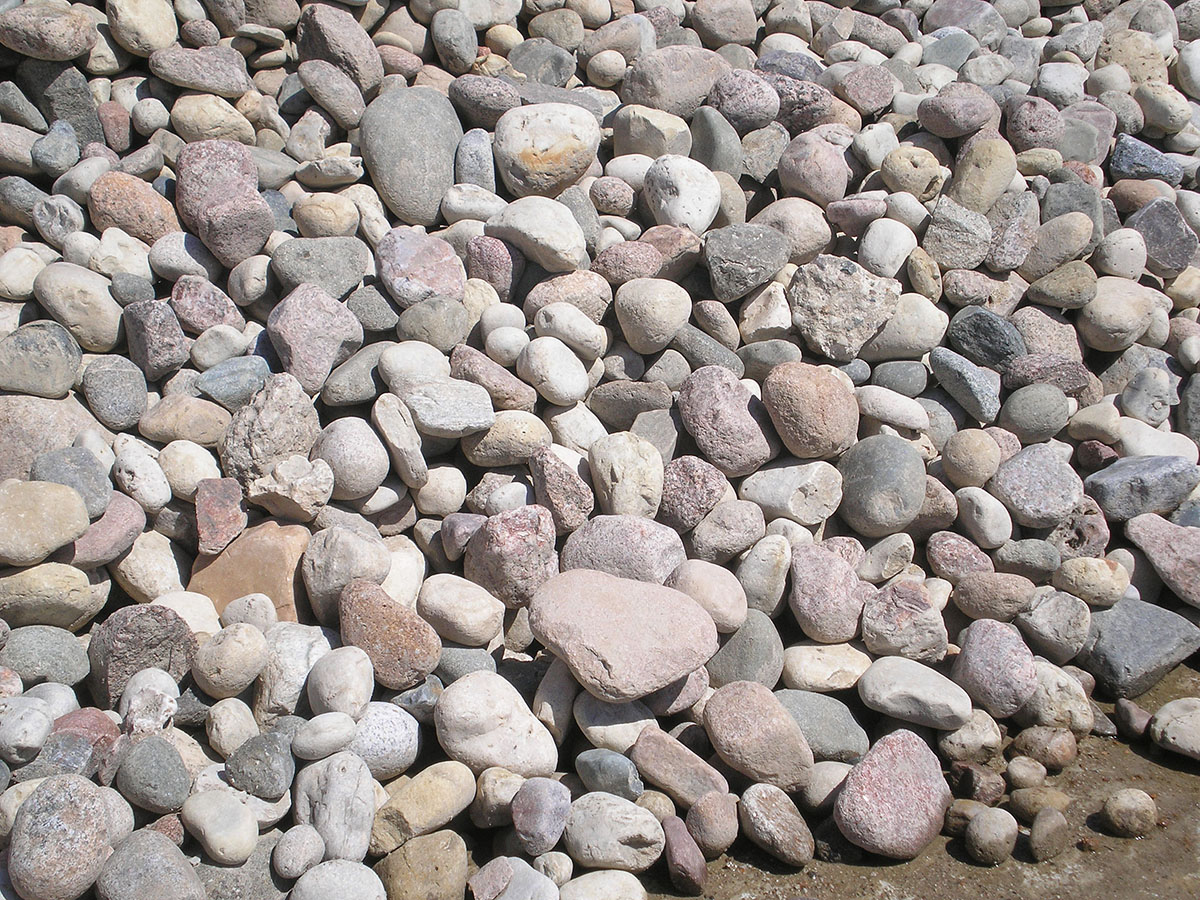
For a luxurious, elegant look, marble rocks are an excellent choice for a dry rock bed. Their smooth surface and striking veining patterns give a sophisticated and timeless appearance. While marble is more commonly associated with countertops or flooring, it can also be used outdoors to create a high-end drainage solution that enhances the beauty of your garden.
Marble’s natural color variations—ranging from white to gray to soft pink—can complement a variety of outdoor styles, from modern minimalist to classic Mediterranean gardens. Marble stones can be arranged in clean, straight lines for a more contemporary feel or used in a more organic layout for a naturalistic look.
Although marble is typically more expensive than other options, its durability and visual appeal make it worth the investment. The stones allow water to drain efficiently, while their elegant appearance creates a beautiful feature in your landscape. Marble also works well as part of a dry creek bed or around garden borders where drainage is needed but you also want to add a touch of sophistication.
15. Crushed Granite Drainage Bed

Crushed granite offers a unique and visually appealing solution for creating a dry rock bed for drainage. The angular pieces of granite are often smaller in size, providing a more compact and stable surface for managing water runoff. The material comes in a range of colors, from rich reds to cool blues, allowing you to choose the perfect option for your outdoor aesthetic.
Crushed granite works well in areas that experience heavy water runoff, such as driveways, paths, or garden beds. The stones interlock to form a solid surface while still allowing for water to filter through and be directed away from critical areas. Crushed granite is highly durable and can withstand high foot traffic, making it a practical option for walkways or areas with regular use.
For an added touch of visual interest, crushed granite can be paired with larger stones or other materials, such as cobblestones or river rocks. This combination creates a beautiful contrast in color and texture, enhancing the overall look of your outdoor space while providing effective drainage.
Conclusion
Creating a dry rock bed for drainage is not only a practical solution for managing water runoff but also an opportunity to enhance the beauty and functionality of your outdoor space. From river rocks and pebbles to more sophisticated options like marble and quartzite, there are many materials to choose from that can suit a variety of garden styles and drainage needs.
Whether you’re looking to improve the flow of water in your yard, create a stunning dry creek bed, or simply prevent pooling around structures, a well-designed rock bed can help. Each of the materials we discussed offers distinct advantages, from durability to aesthetic appeal, ensuring that you can find the perfect fit for your landscape.
By carefully selecting the right type of stone and strategically placing your dry rock bed, you can enjoy both a visually stunning outdoor space and a functional drainage system that addresses water management issues efficiently. With the right materials and design, your dry rock bed can become a beautiful feature that complements the overall look of your garden while maintaining its practicality.

